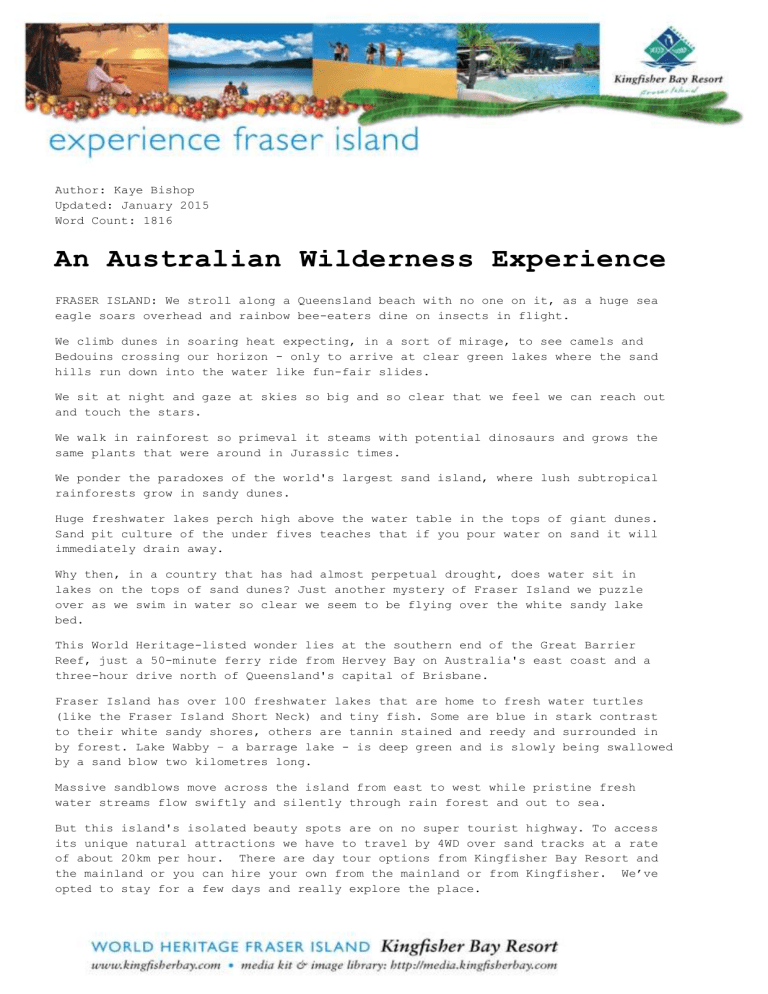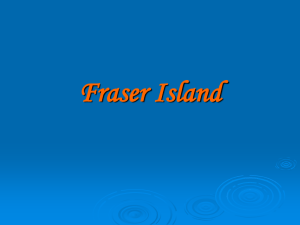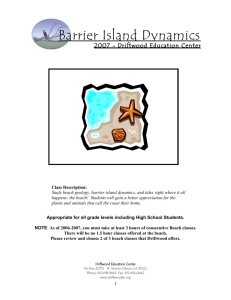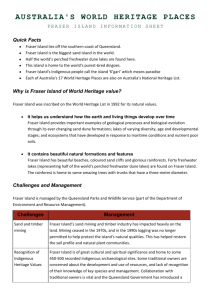Word - Kingfisher Bay Resort

Author: Kaye Bishop
Updated: January 2015
Word Count: 1816
An Australian Wilderness Experience
FRASER ISLAND: We stroll along a Queensland beach with no one on it, as a huge sea eagle soars overhead and rainbow bee-eaters dine on insects in flight.
We climb dunes in soaring heat expecting, in a sort of mirage, to see camels and
Bedouins crossing our horizon - only to arrive at clear green lakes where the sand hills run down into the water like fun-fair slides.
We sit at night and gaze at skies so big and so clear that we feel we can reach out and touch the stars.
We walk in rainforest so primeval it steams with potential dinosaurs and grows the same plants that were around in Jurassic times.
We ponder the paradoxes of the world's largest sand island, where lush subtropical rainforests grow in sandy dunes.
Huge freshwater lakes perch high above the water table in the tops of giant dunes.
Sand pit culture of the under fives teaches that if you pour water on sand it will immediately drain away.
Why then, in a country that has had almost perpetual drought, does water sit in lakes on the tops of sand dunes? Just another mystery of Fraser Island we puzzle over as we swim in water so clear we seem to be flying over the white sandy lake bed.
This World Heritage-listed wonder lies at the southern end of the Great Barrier
Reef, just a 50-minute ferry ride from Hervey Bay on Australia's east coast and a three-hour drive north of Queensland's capital of Brisbane.
Fraser Island has over 100 freshwater lakes that are home to fresh water turtles
(like the Fraser Island Short Neck) and tiny fish. Some are blue in stark contrast to their white sandy shores, others are tannin stained and reedy and surrounded in by forest. Lake Wabby – a barrage lake - is deep green and is slowly being swallowed by a sand blow two kilometres long.
Massive sandblows move across the island from east to west while pristine fresh water streams flow swiftly and silently through rain forest and out to sea.
But this island's isolated beauty spots are on no super tourist highway. To access its unique natural attractions we have to travel by 4WD over sand tracks at a rate of about 20km per hour. There are day tour options from Kingfisher Bay Resort and the mainland or you can hire your own from the mainland or from Kingfisher. We’ve opted to stay for a few days and really explore the place.
Access to Fraser Island is easy. The gateway to the island is from River Heads on the Fraser Coast mainland to Kingfisher Bay Resort, an eco resort that sends us out to explore the island and pampers us after a hard day's sightseeing. (Sitting in the spa sipping champagne and watching the sun set is heaven after the hell of climbing up the side of a sand blow!)
We are met by resort staff at Hervey Bay/Fraser Coast Airport and taken to catch a ferry to Fraser Island. Our bags go straight from the plane to our room.
Cruising across the Great Sandy Strait for 50 minutes we are advised to keep an eye out for dolphins, Dugong and turtles and, from August to October, Humpback and Minke
Whales! The resort has teamed with the pioneers of whale-watching in region – Jill and Brian Perry – to run tours in season.
From the water, the island stretches as far as the eye can see (it is 75 miles long) and it is difficult to realise that the rolling hills (over 700 foot in height), covered in eucalypt and rainforest, are all dunes.
As the boat nears a long jetty, Kingfisher Bay Resort is just visible through the trees that fringe its beach. The modern Australian-style wooden buildings with curving roofs have been built in an amphitheatre overlooking the bay and merge with the resort's natural environment.
The resort is surrounded by a wealth of plant and animals. Within a few minutes walk of our hotel room rare Acid Frogs, Microbats and Sugar Gliders can be seen at night.
We go spotlighting with a Ranger to see what else is out there.
In the morning, with binoculars supplied, we join another Ranger on a bird watching expedition. There are 354 species of bird, which live on or visit the island, including migratory waders, large colourful parrots and honeyeaters.
The famous Fraser Island Satinay trees (taken to line the banks of the Suez Canal after the war - logging stopped in 1992) grow in amongst heaths and other natives include the Wide Bay Boronia and Foxtail Sedge, which is only found this Region.
We learn there is a year-round, bountiful supply of plants providing bush tucker, natural medicines and beautiful wildflowers. We numb our mouths with primitive pain killers and revive them by drinking tea made from Lemon-scented Tea Tree leaves plucked from the proliferation of bush by our knowledgable Ranger.
A freshwater creek spills into the ocean close to the resort and is edged by five mangrove species. Sea Eagles, Osprey, fish and crabs are found among the mangroves.
Australia's purest breed of dingo roams the island. The resort is ringed by a dingo fence, but we see footprints along the beach and then the dog itself hunting around the beach that borders the resort.
The resort employs a private Ranger staff of around 20. They include Marine
Biologists, Botanists, Anthropologists, Zoologists and former National Parks and
Wildlife Service employees.
These Rangers guide guests through the contrasting landscapes of lush rainforest, huge slow moving sandblows, endless beaches, shipwrecks, crystal-clear lakes, fast flowing streams and spectacular coloured sands cliffs.
Each day a range of activities is offered by Rangers including guided walks, night spotlighting, stargazing, bird watching and Australian bush tucker walks. For children, there is a Junior Eco Ranger program on weekends and school holidays.
We take a full-day, Ranger-guided off-road day tour looking to reacquaint ourselves with the cultural and natural heritage of the island (Fraser Explorer one and two day tours also run from the mainland if you don’t have the time to stay over).
We learn about the Aboriginal heritage - the sources of bush tucker, the lifestyle, myths and legends and hear the tall tales, and true, of the timber logging days.
We drive along Seventy-Five Mile Beach, an ocean beach that is a gazette highway where all road rules apply.
The beach is busy with four-wheel-drives, campers, tour buses and people fishing - a strong contrast from the tranquility of Kingfisher Bay and the deserted beaches on the western side of the island.
There are some extra rules for driving on this beach like giving way to planes landing. Six-seater planes land and take off from the beach taking visitors for joy flights over the lakes and sandblows.
We stop to swim in Eli Creek where fresh water pours out to sea from an inland spring at the rate of nearly 80 million gallons a day. It's fresh and cold and we float quickly to the beach.
We see one of the many wrecks around the island. The SS Maheno was a luxury cruise ship, which washed up on the beach in 1935 and is slowing rusting into the sand.
At The Pinnacles we marvel at the spires of coloured sands in 72 shades of yellow and red. These cliffs were formed from dust blown from the central dessert of
Australia 800,000 years ago and the iron in the clay has formed and iron oxide coating around the sand grains.
After lunch at Eurong Beach Resort, we go off the beach to Central Station, a former logging township and walk through the rainforest, which borders Wanggoolba Creek.
Here we see King Ferns growing in the creek bed - they are believed to have evolved
320 million years ago and are extremely rare and endangered.
Then onwards to Lake McKenzie, a beautiful blue lake perched high in the whites sands of a dune and fringed by eucalypt forest.
This is a big day out but well worth it for the sights and the information we have gained. We note the places we want to come back to and seek information from the
Rangers on other places.
Then we hire a 4WD from the resort and explore the island on our own – searching out
our own private pockets.
Fraser Island is famous for its 4WD sand tracks and the resort has a 4WD training video to help ensure newcomers to the island enjoy the splendors without suffering any of the potential pitfalls. Periodically during the year, the resort teams up with the folks from Australian Offroad Academy to run sand driving courses for novices – it’s a great idea.
There are plenty of places to explore just walking from the resort and many walks have explanatory signs along the way. More adventurous, and longer, walks are organised by the Rangers and we spend a half day walking first along the beach, then through the forest for a swim in magnificent Lake McKenzie.
Multi-award-winning Kingfisher Bay is built to strict environmental guidelines offering all the amenities of an island resort, while blending harmoniously with the island's sensitive ecological system.
The resort has a 152-room hotel and 109 self-contained villas, which sleep from four to eight people and larger holiday houses. All have large private decks overlooking sea, bush or lakes. The rooms are well appointed with refrigerators, tea and coffee making facilities, TV, air-conditioning, ISD telephones and irons. Many have spas.
There are four swimming pools and a spa, bars, restaurants, shopping village with a day spa, a fishing school, tennis courts, conference facilities and 4WD hire.
Temperatures average 29C in summer and 22C in winter.
The restaurants cater for every mood and there are prices to suit every budget, great pizza and salad at The Sand Bar, bush-inspired dining in Seabelle and casual buffet/snack and Al a Carte spreads in The Maheno.
Kingfisher Bay is nestled into a natural sand amphitheatre overlooking the protected waters of the Great Sandy Strait, where you can swim, fish, canoe or sail. There is a fishing guide, who will make sure you catch fish of the correct size and keep only what chef can cook for you to eat. Fishing clinics and fishing trips are run daily.
The resort also provides visitors with the opportunity to experience the heritage values of Fraser Island and the Great Sandy Strait on nature's terms. There is so much to see and do on this amazing island and we have already extended our stay.
We leave knowing we must return. There are over 100 lakes on the island and we have explored four. We have swum in one fresh water creek, canoed on another and followed one through a rainforest; there are over 100 more to enjoy - next time!
For more information call the Fraser Island specialists on 1800 FRASER.
This story may be reproduced without permission for editorial purposes. Please send an original copy to media@kingfisherbay.com
.
Further reference: http://www.kingfisherbay.com/images/media/fraser-facts/lakesoffraserisland.pdf








